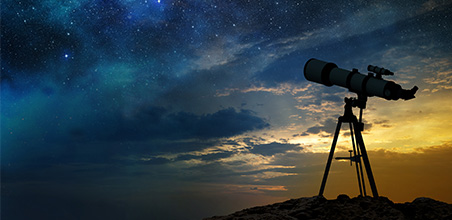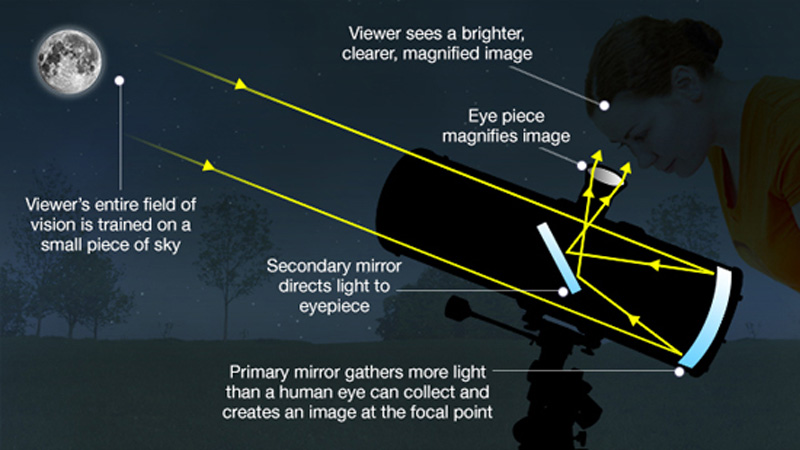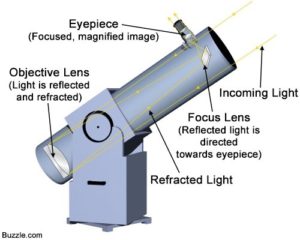
There are a lot of great inventions that surround us from every place; however, many of us do not know about them or how they work. This assignment gave the chance to look more rooted in technology and see how they affect the world around us. The following is a technical description of a piece of technology developed by a reflection essay.
Telescope
Ahmed Elgharably
The City College of New York
Supervised by Professor Elizabeth Van Uhl, ENGL 21007.
Abstract
A telescope is one of the greatest inventions that has happened in all-time history. Without the telescope, we would have a lot less knowledge about the outer space and the universe beyond the Earth in our current time. The first telescope appeared in Netherlands, 1608, by an eyeglass maker called Hans Lippershey. “Galileo improved on this design the following year and applied it to astronomy. In 1611, Johannes Kepler described how a far more useful telescope could be made with a convex objective lens and a convex eyepiece lens and by 1655 astronomers such as Christiaan Huygens was building powerful but unwieldy Keplerian telescopes with compound eyepieces.”(King, H. C., 1967, p.82) Throughout the years, the telescope was developed by various scientists such as Isaac Newton and John Hadley.

Telescope
A telescope is an optical instrument designed to make distant objects nearer, containing an arrangement of lenses or of curved mirrors and lenses, by which rays of light are collected and focused and the resulting image magnified. Telescopes went through many processes to get improved in many areas. These areas include clearance, depth, magnification, lens, focus, focal length, and many other aspects. The telescope has much significance to science and discoveries. Telescopes are better than our eyes as they see many colors, and they can see from very large distances. Telescopes can collect light that our eyes cannot see such as radio waves, microwave, infrared, ultraviol2et, X-rays, and gamma. (King, H. C., 1967, p.61) Telescopes can be used to view physical objects, look at the space, sky, stars, and it can see distant objects such as mountains, boats in a sea or even a bird on top of a building.
Components

There are a lot of different types of telescopes that exist; each has its specific purpose. For example, we need a different telescope for astrophotography than what you need if you are a beginner trying to look at the moon. However, all types of telescopes share a similar structure, the structure contains significant parts, and each major part has subparts. These significant parts work together to give us the intended function of the telescope. These major parts remain fundamentally unchanged.
Lenses and Mirrors
The lens is among the essential parts of the telescope. The lens constitutes of the Convex lens which refers to the lens which merges the light rays at a particular point, that travels through it. Also, concave lenses cause light to spread out, resulting in a smaller image for the viewer. Moreover, A concave mirror is a mirror with a curved reflecting surface which is curved inwards. The lens also constitutes of the focusing distance, field of view, magnification and resolution. The purpose of the lens is to collect and control the movement of light and the view in which the sky is viewed.

Figure 3 Baxamusa, B. N. (2018, November 20). Types of Telescopes You Didn’t Know About. Retrieved from https://universavvy.com/types-of-telescopes
The Eyepiece.
The eyepiece is a part of the ocular lens, usually the lens that is closest to the eye when someone looks through the device. It provides the lock for security of the telescope. The eyepiece prevents the ocular lens from falling and eventually breaking down or disappearing. It also enhances a clear view from the lens to the object. “When you replace a workaday eyepiece with one of genuine quality, you may be astounded at the difference in your viewing experience” (Mike Crystal, 2017). As a result, a higher magnification level is provided when the telescope contains an eyepiece with a shorter wavelength.Figure 3 Baxamusa, B. N. (2018, November 20). Types of Telescopes You Didn’t Know About. Retrieved from https://universavvy.com/types-of-telescopes
Structural Support.
While holding a telescope, a person might feel that it is going to be still in the hands, nonetheless, “certainly you will not be able to keep the apparatus still enough to prevent disruptions to the visual field.” Therefore, telescopes are usually mounted on tripods, which are fixed stands for the telescope. The tripod is made of at least three stands. It holds and retains the telescope on its surface. “The tripod is made in a way that it can support the telescope in slanted, straight, or inverted positions.” (Self.Blog, 2011) At the same time, an observer can quickly move the telescope to different directions quickly.
Half Pillar
One part that is usually used in a telescope is the Half pillar, which is used to raise or lower the mounting position. This sets the telescope in position on the tripod to work as required.
Telescope Tube
The telescope tube has the primary mirror. Usually, the telescope tube has 8 inches diameter, and it has a tube cover. The telescope tube enhances the setting of the focal length, the distance between the center of a lens or curved mirror and its focus, through controlling the knob which is usually below the visual back. Therefore, the telescope tube makes a vital part of the telescope functionality.
Finderscope
This is a minor telescope which is mounted on the main tube, usually has a smaller magnification than the main telescope, providing a much larger field of view, useful for manually aiming. The finderscope is used to locate the main object which is to be viewed. It locates and directs the telescope to the main object for a clear view.
Conclusion
Since the 16th century, telescopes have been used especially in the field of space exploration or astronomy. Today, telescopes are used by space and astronomical departments to get information about space. They are also used by learners and visitors to watch and enjoy viewing space and different heavenly bodies.
References
King, H. C. (1967). Pictorial guide to the stars. New York: Crowell.
Crystal, M. (2019, March 02). Parts of a Telescope. Retrieved from https://sciencing.com/parts-
telescope-5089118.html
North, G. (n.d.). Telescope optics. Advanced Amateur Astronomy, 1-26.
Code for People. (n.d.). Retrieved from http://www.codeforpeople.com/important-telescope-parts-functions/
Reflection Essay
A student in an Engineering school must predict that he will be put in a situation that he has to describe a device or a piece of technology. However, I never imagined that I would di it this early. The technical description paper was all about choosing a piece of technology and describing it in details. For example, the inner and outer parts, subparts and all its attributes. Throughout the process of writing this paper, I went through stages and challenges. I also learned a lot and improved some of my weaknesses.
The first stage I went through was choosing the device that I will describe. This step, I found it the most challenging, I did not want to choose a device that would be hard to describe since it might have a lot of parts and more of subparts. I thought of a lot of devices such as an apple watch, I phones or even a vehicle’s electrical system, this would be misleading for me and most likely I would forget to describe an important part or even neglect it because it is hard to describe. However, one night I had the curiosity of how telescopes work, this was a good kick start. I started searching up how telescopes work and I found that it composes of simple parts and it is manageable to understand and describe. At this point, I decided to do my technical description of the telescope.
The second stage, which is searching for the intended functions of each part and subpart, was also challenging. This is because I found hardships of converting the description of the functions into my own words or even paraphrasing since the description was straight forward. This leads me to use a lot of citations and references. The process of citing was a challenge itself since citation has its specific structure and format. Nevertheless, This stage took much time, but it was fun because I wanted to know how telescopes work, so I never felt with exhaustion.
On the other side, after finishing the process of writing the description, I started to analyze the strengths I gained and weaknesses that I still suffer. The most important strength I gained is practicing citation in the APA format even though I did not master it yet. The second strength I gained is thinking outside the box, the way I can put sentences in my own words through understanding them first even if they seem impossible to paraphrase. These were some strengths that will definitely help me in my future writings.
However, I was able to detect some of my weaknesses. The most important weakness is how to organize the flow of my description, I lacked the ability to put myself in the reader’s shoes and see how can he comprehend my writing. At some points, I described subparts that do not belong to the major part that I was actually describing. Therefore, the organization in my writing must be improved.
At the end of my reflection and self-evaluation, I can conclude that it is very important that I detected my points of weaknesses in order for me to avoid these weaknesses in my future writings by practicing them. Nevertheless, the experience of looking deeper into a piece technology is very entertaining as I learned much information, that I never thought that I would know, added to my knowledge.

